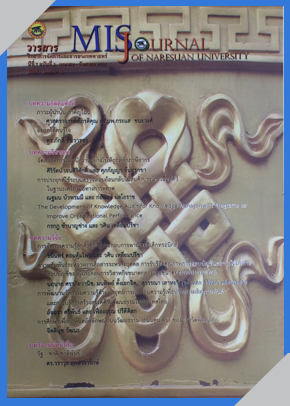การศึกษาเพื่อกำหนดอัตลักษณ์ถนนวัฒนธรรม (ถนนคนเดิน) ของจังหวัดพิษณุโลก
Main Article Content
บทคัดย่อ
การวิจัยครั้งนี้มีวัตถุประสงค์เพื่อกําหนดอัตลักษณ์ถนนวัฒนธรรม (ถนนคนเดิน) ของจังหวัดพิษณุโลก ให้เป็นที่รู้จักและ นําไปสู่การสร้างจุดขายการท่องเท ี่ ยวเพ ิ่ มขึ้น โดยศึกษาวิถีชีวิต วัฒนธรรม และประเพณีของประชาคมในพื้นที่จากนั้นนําไป วิเคราะห์หาศักยภาพเพื่อส่งเสริมการท่องเที่ยวต่อไป วิธีการวิจัยใช้การเก็บข้อมูลด้วยแบบสอบถามนักท่องเที่ยวจํานวน 400 ราย โดยใช้ข้อมูลสถิตินักท่องเที่ยวทั้งชาวไทย และต่างประเทศที่ มาเที่ยวจังหวัดพิษณุโลกในปีพ.ศ. 2550 และการสัมภาษณ์เชิงลึกภาคีผู้เกี่ยวข้อง ได้แก่ ผู้ประกอบการสินค้า OTOP จํานวน 20 คน และประชาชนในจังหวัดพิษณุโลก จํานวน 15 คน รวม 35 คน จากนั้นนําข้อมูลจากแบบสอบถามไป วิเคราะห์หาค่าความถี่ ค่าร้อยละ ค่าเฉลี่ย และค่าเบี่ยงเบนมาตรฐาน ส่วนแบบสัมภาษณ์เชิงลึก นําข้อมูลที่ได้มาวิเคราะห์จุดเด่น โอกาส และหาระดับความพึงพอใจ พร้อมทั้งข้อเสนอแนะ ผลการวิจัยปรากฏดังนี้ การรับรู้ของกลุ่มเป้าหมายต่อการกําหนดอัตลักษณ์ของจังหวัดพิษณุโลก มีความคล้ายคลึงกัน ระหว่างประชากรสองกลุ่ม โดยนักท่องเที่ยวชาวไทยและนักท่องเที่ยวชาวต่างประเทศ เห็นว่า อัตลักษณ์ของจังหวัดพิษณุโลก คือ 1) พระพุทธชินราช 2) สมเด็จพระนเรศวรมหาราช 3) น้ําตก และ 4) ก๋วยเตี๋ยวห้อยขา ซึ่งสอดคล้องกับความเห็นประชาชน และ ผู้ประกอบการสินค้า OTOP แต่ประชาชน และผู้ประกอบการสินค้า OTOP เห็นว่ากล้วยตาก และสุนัขบางแก้วเป็นอัตลักษณ์ของ จังหวัดพิษณุโลก นอกจากนี้ การรับรู้ของประชากรสองกลุ่ม ไม่ได้กล่าวถึง พระนางพญา ไก่ชนพระนเรศวร และดนตรีมังคละ ซึ่ง ปรากฏในข้อมูลเอกสารเกี่ยวกับอัตลักษณ์จังหวัดพิษณุโลก จากผลการวิจัยครั้งนี้ผู้วิจัยได้นําเสนอรูปแบบการจัดภูมิทัศน์ วัฒนธรรมชุมชน เพื่อเป็นแนวทางการจัดการถนนคนเดินภายใต้อัตลักษณ์ถนนวัฒนธรรม เพื่อสร้างการรับรู้และส่งเสริมการท่องเที่ยวของจังหวัดพิษณุโลก ที่จะส่งผลให้เกิดการกระตุ้นเศรษฐกิจ สร้างงาน สร้างรายได้ให้ประชาชนในท้องถิ่นต่อไป
A Study to Determine the Identity of the Phitsanulok Cultural Street (Walking Street)
This research study was aimed to determine the identity of a cultural street (walking street) of Phitsanulok province based on the study of the perceptions of tourists and community members and to study the ways of life, cultures and traditions of the local people. The results were analyzed to identify the potential for tourism promotion and positioning. The study employed questionnaires to collect the data from 400 tourists based on the 2007 statistical data of Thai and foreign tourists in Phitsanulok province as well as in-depth interviews with 35 multi-stakeholders, comprising 20 OTOP entrepreneurs and 15 local residents in Phitsanulok province. The data from the questionnaires were then analyzed to find the frequency, percentage, mean and standard deviation. The data from the in-depth interviews were analyzed to identify the strengths and the opportunities, to find the satisfaction levels, and to make suggestions. The findings were as follows: The perceptions of the two target groups of Thai and foreign tourists were similar in that both groups perceived that the identity of Phitsanulok province consisted of 1) Phra Buddhachinnaraj Buddha image; 2) King Naresuan the Great; 3) the waterfalls; and 4) “Kuay Taew Hoy Kha” traditional noodles. This was in accordance with the opinions of the local residents and the OTOP entrepreneurs. However, the local residents and the OTOP entrepreneurs projected that sun-dried bananas and Thai Bang-Kaew dogs also contributed to the positioning of Phitsanulok identity. Moreover, it was observed that the perceptions of both groups did not include Phra Nangphaya amulets, Naresuan fighting cocks and Mangkhala folk music as the province’s signatures although these items were noted in the documents related to the identity of Phitsanulok province. Based on these findings, the researcher presented a pattern for landscaping a cultural community to act as a guideline for the management of the walking street positioned as a cultural street with an aim to create an awareness of and to promote tourism in Phitsanulok province. It was expected that this would consequently encourage the economic growth generating jobs and income for the local people.


